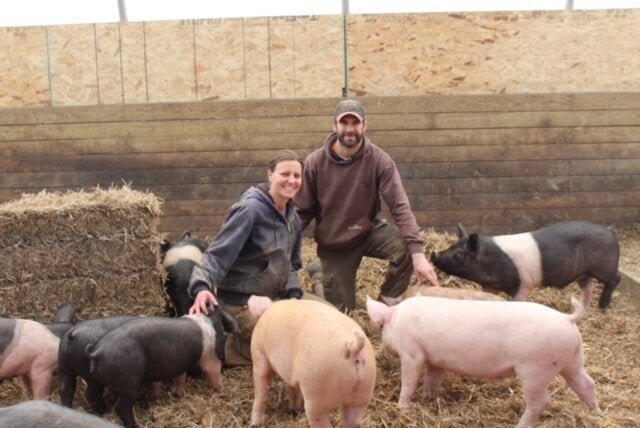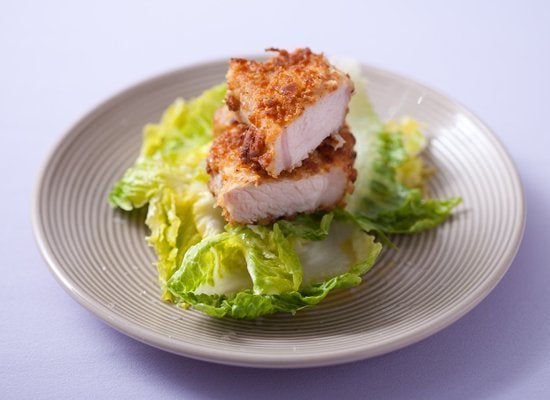I’ve always loved filling up the freezer with double batches of soup, quart containers of bone broth and blanched garden vegetables. When my “stocking up” commandeered so much freezer space that there was no room even for ice cubes, I upgraded to semipro squirrel-it-away status and bought a dented upright freezer from the back room of my local appliance store. It’s tucked in a dusty corner of my basement and I make good use of it all year long.
But this year, because of the coronavirus pandemic, is different. In May, I submitted a $100 deposit for a half a pig – 50 to 70 pounds’ worth — from Zweber Farms, an organic family farm in Elko, Minnesota. It was a purchase that required some budgetary decision-making now and for the future, since I’ll owe another $200 when the meat is ready (sometime between August and December).
There are other challenges, too. When I pick up my three 12-by-18-inch boxes of processed meat, I’ll need to cram them all into the basement freezer and hope I still have some space for my autumn garden harvest (not to mention ice cubes). Then, over the long winter, I’ll need to stay up-to-date on my inventory and cook it all wisely and well. According to the farm, a typical half-pig purchase includes 8 to 10 pounds of pork chops, three roasts, two quarter hams, 10 to 14 pounds of bacon, three pounds of ribs and 15 pounds of ground meat.

Why a pig? Why now? Until meat plants started shutting down as a response to COVID-19 and stores began limiting meat purchases, I’d never considered doing anything like this. Then I ran across a social media posting from the farm.
The Zwebers knew that many other pig farmers would face a glut of animals as a result of plant shutdowns. So, while they usually raise 100 pigs each year, they were considering buying 200 this year. They asked customers for in-advance commitments before making the financial leap for the additional animals. It turns out that many people were eager to say yes. The farm sold out within 72 hours of making the request. They’re now informing new applicants they’ll need to wait for their pig until at least spring 2021.
“It’s been nuts,” Emily Zweber told HuffPost. “We sold whole and half pigs in the past, but we often had to call people to ask if they were still interested each year, and it took some time to get commitments for all the pigs. We’ve never had a response like this before. When I tell people how long it might be until delivery, they say, ‘That’s fine; please just keep me on the waiting list.’”
Why I considered buying half a pig
I responded to the farm’s post for a few reasons: First, I’m sheltering in place with some committed meat eaters. Second, I worry that meat costs will skyrocket, and I wanted to lock in a price that, while a stretch, was still within our current budget. And finally, perhaps most importantly, I have a high degree of trust for this particular farm.
I belong to a group of Twin Cities women in the food industry, Women Who Really Cook, and we’d taken a late-summer tour of the Zweber place a couple years ago. We met their three children, walked through the dairy barns, saw the cows in the pastures and ended our day with wine and cheese under the 200-year-old bur oak tree in their front yard.
Zweber, who has been farming more than 14 years, was my ambassador to the joys of knowing your farmer and shopping close to home. In my case, the shopping happens at a fourth-generation farm, in operation since in 1906, that’s about an hour’s drive from my house. I know that they’re farmer-owners with Organic Valley, one of the largest farmer-owned organic cooperatives in the U.S. and one of the world’s largest organic brands. At the end of that visit with my group, many of us stopped by the Zweber farmstand to buy their beef, pork and chicken. Now, I was ready to buy even more – a freezer full, in fact.
Filling the freezer
To prepare for my pig’s arrival, I talked with people who’ve already purchased whole animals. Ilke McAliley, from Rock Hill, South Carolina, has joined with friends for cow and pig purchases from Watson Farms Pastured Meats in Chester, South Carolina.
“My interest in doing this began with becoming aware of the environmental impact of the large-scale meat industry,” McAliley said. “It’s good meat from well-cared-for animals, so my advice is to appreciate it and cook it lovingly. Everyone who tasted the hamburgers we made, for example, always commented on how much better they tasted compared to store-bought ground beef.”

McAliley had advice for groups chipping in on a purchase. “If you’re sharing the meat with others, make sure everyone is ready with empty freezers and can come and pick it up as soon as it’s delivered. When we got the half-cow, for example, it came in seven boxes, so everyone had to come get their share right away.”
Keeping track of inventory is important, too: “If I do this again, I’ll print out the cut list with the amounts of each and tape it on the freezer door, then cross out cuts as I use them,” McAliley said. “Otherwise, it’s hard to dig through a chest freezer to figure out what’s left.”
Laura Reid from Fort Mill, South Carolina, participated with McAliley in the group buy. “The benefits are that you get good quality meat at a decent price,” she said. “Also, getting a whole animal allows you to work with cuts you wouldn’t normally buy, like cow bones, liver and uncured bacon.”
Still, Reid noted, there can be challenges to the “group buy” concept, depending on who’s in the group and how they get along with one another. “Splitting the meat equitably, and allowing for cut preferences, could be a challenge,” she cautioned.
Finally, Reid said, you must have enough freezer space. “You can fit only about one-sixth of a cow in most refrigerator freezers, assuming they’re mostly empty to begin with.”
Talk to your farmers
When she was living in Indiana and working as editor-in-chief of Edible Michiana, Maya Parson regularly bought half a hog from Blue Heron Farm, a small family farm in Goshen, Indiana, that raises pastured, acorn-fed hogs. “We visited the farm on several occasions,” she said. “We knew the pigs spent their lives in beautiful pastures, eating acorns and sometimes whey from a nearby cheese producer.”
When asked about advice for those considering a whole animal purchase, Parson said: “Don’t be intimidated! It should be a great opportunity to support a local farm, eat top-quality meat at a good price and kick your cooking skills up a notch. Ask your farmers for tips on cooking and storage, because they’re the experts.”
If you’ve read this far ...
Not everyone has the space, money or desire to enter into a whole-animal buying venture. But if you’re interested and want to find out what’s possible in your area, check Eatwild’s directory of 1,400 pasture-based farms that sell beef, pork, lamb, veal, goat, elk, venison, yak, chickens, ducks, rabbits, turkeys, eggs, milk, cheeses and even wild-caught salmon. Another resource, Local Harvest, lists more than 40,000 family farms and farmers’ markets.
And when you eventually realize, “I’m gonna need a bigger freezer,” check with a big box retailer or local appliance store to find the right one.
